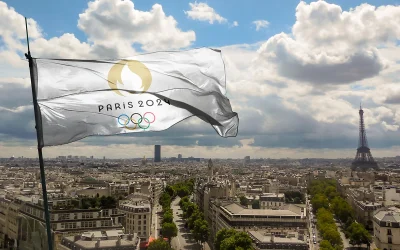Indonesia: 13,466 islands… so why does one get all the attention?
Bali is by far the best known and also gets the lion’s share of international visitors.
For tourism to survive and thrive in Indonesia, visitors need to re-focus their attention on Indonesia-other-than-Bali.
Indonesia’s glorious tropical beaches and lush mountain backdrops fill tourist brochures with idyllic images but eco-tourism is the main driver in positive directions, the saviour for this dynamic country’s fragile environment.
The country’s extraordinarily diverse bio-systems support indigenous wildlife that perilously clings on for survival. Already a strong attraction for dedicated travellers in search of something other than resorts, cocktails and beaches (not that there’s anything wrong with those of course), this is what makes Indonesia absolutely special.

I’ve written before about personal encounters with orang-utans in Kalimantan and with tigers, rhinos and elephants in Sumatra. (See www.nakedhungrytraveller.com.au/orangutans-and-others). I’ve climbed Mount Bromo and searched out Dutch heritage architecture in Malang, East Java. I’ve delved into Lombok’s mountainous interior resplendently draped in multitudes of waterfalls and got far from tourists on Bali as possible. I’ve tripped into the darker side of Jakarta’s slums on bizarre shopping escapades, but a recent trip to Sulawesi and Maluku provinces showed me just how much more there is to Indonesia’s complex archipelago than I could ever have imagined.
While Indonesia is the world’s most populous Islamic nation, it encompasses sizeable Christian and Animist communities. Hindus and Buddhists also add their polytheistic flavours to the nation’s religious melting pot.
Over 500 languages are spoken in Indonesia, though Bahasa Indonesia is taught to all students across the country and is the main lingua franca.
With countless multi-cultural communities and wildlife sharing the world’s most diverse rainforests all in a single country, what’s not to love?
Manado
Daily Garuda flights connect Jakarta to Manado in North Sulawesi Province.
Manado lies north of the Equator, close enough to the Philippines to share similar histories and cultural ties.
The local Minahasan people were intrepid seafarers, voyaging throughout the South China Sea including the Philippines and south beyond Timor to northern Australia in search of kupang (sea cucumber).
Like Mindanao in the southern Philippines, Manado’s population is a mix of Christian and Muslim communities. Civil strife flares up occasionally (as in Ambon in the mid 90s, more on that later) but first impression indicates a peaceable coexistence nowadays.
Manado’s name derives from Minahasan for ’in the distance’ or ’on the far coast’.
It’s a long way from Jakarta, that’s for sure.
Manado is making its mark on the eco-traveller’s list of preferred destinations because it’s the closest access point to Bunaken National Marine Park.

The majority of international visitors to Manado carry masks, fins and PADI certificates. The diving around Bunaken is some of the world’s best.
Fringing reef from Bunaken Island extends almost 500 metres to a very deep channel, some 1,566 metres in fact. Snorkelling over the abyss I could feel cold water upwelling beneath my sunburnt back. No wonder large pelagic fish, whales, turtles and rays hang out around Bunaken. Cold deep water means lots of fish food. Seven of the world’s eight species of giant clam live around Bunaken while the park boasts at least 70% of all known fish species of the Indo-Pacific. Coral species are manifold in abundance with Bunaken claiming to have seven times more genera of coral than all of Hawaii.
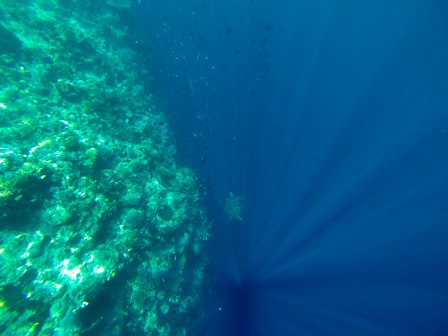
Bunaken Marine National Park lies approximately ten kilometres offshore from Manado. Boats to Bunaken leave from the funky little Dermaga Marina Plaza near central Manado. Major hotels in Manado can arrange boat transfers to Bunaken for day trips if the island’s small assortment of basic resorts doesn’t appeal.

Check out the pirate guarding the entrance to a very out-of-place and empty tourist restaurant at the marina. Minahasan were formidable pirates in their heyday but this replica looks more like a Jamaican rum swizzling Captain Hook than a Minahasan vagabond.
Volcanic highlands surrounding town include Indonesia’s third largest lake, the wonderfully picturesque Lake Tondano with nearby villages still strong in Minahasan culture including historic ’Waruga’ stone graves built above ground and strangely similar to the vault crypts of New Orleans.

Lake Tondano lies approximately 600 metres above sea level, slightly less steamy than sweltering Manado. A few fish restaurants line the lakeshore, clearly providing a favourite day trip destination for hungry locals. The mountains and hills encompassing the lake create a lush atmosphere, imbuing a desire to linger. I wish I’d had more time there to simply relax.
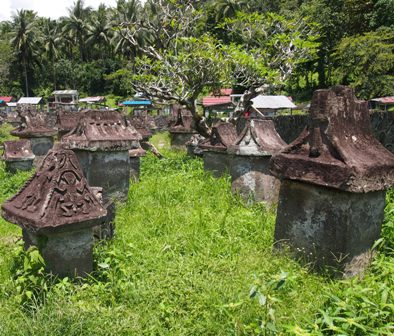
The ’Waruga’ stone graves at Taman Purbakala Waruga-Waruga was designated a UNESCO World Heritage Site in 1995. Of all the UNESCO World Heritage Sites I’ve visited, this was the least touristy.
Signage is minimal. It’s not easy to find. A single local guide is occasionally available to show visitors around the cemetery, the majority of whose graves were moved from other locations for preservation.
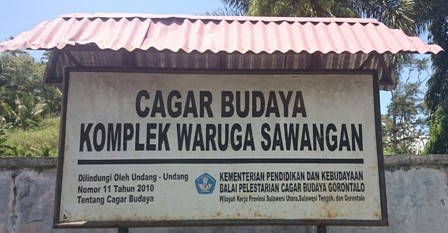
’Waruga’ graves look like stone boxes, upright and surprisingly narrow. Bodies were interred in a seated position always facing north as the belief was that Minahasan ancestors came to Manado from the north, perhaps the Philippines or beyond.
Crammed into the smallish hot boxes, men’s arms were crossed at the chest while women’s were folded with hands facing out, representative of traditional roles men and women played in Minahasan society. Bodies decayed rapidly in the harsh tropical sunlight but intricate carvings on each ’Waruga’ tomb served to remind friends and relatives of the long-cooked deceased.
Curiously there are a number of Portuguese and Spanish ’Waruga’ graves amongst the Minahasan. The Dutch banned ’Waruga’ graves in 1828, plenty of time before then for earlier Portuguese and Spanish colonists to adopt the local tradition.

Not far from Lake Tonando is the kitsch Bukit Kasih ’Hill of Love’, 2,435 steps over steaming rotten-egg stinking sulphur vents to a hill overlooking lush volcanic plains below.
Tangkoko National Park is home to two endangered primates that are surprisingly easy to spot when accompanied by an expert guide. If you want to get up close and personal with one of the world’s smallest monkeys, the Tarsier, or follow a troupe of Crested Black Macaques through jungle to a remote black sand beach, this is the place.

The park is located on the southern side of the peninsula opposite Manado (approximately two hours drive over steep and narrow mountain roads) and represents a good news story about the preservation of two endangered indigenous species.
Tarsiers are small and cute. For that, they are often snared from forests to keep as house pets. Crested Black Macaques are larger primates with sharp teeth and aggressive body language. Be wary of approaching macaques, don’t touch; they bite and rabies is a problem. Consequently they haven’t gained local acceptance as house pets like Tarsiers but they do occasionally appear on butcher’s blocks in Manado’s central market as ’bush meat’.
Tangkoko National Park may be small but it’s densely forested, fairly well protected from poachers and supports a few thriving troupes of Crested Black Macaques. I thought my chance of spotting one in the wild was akin to winning second prize in a beauty contest but was delighted to wander amongst a troupe of at least 30 macaques while they foraged in the jungle’s gloaming light.
A Tarsier on the other hand is mostly nocturnal (those huge eyes can easily spot moths, small lizards and other insects) and is about as easy to find as a green needle in the rainforest. Luckily our guide had found one earlier, remembered its location where its tiny brown body was wedged in a slim brown cleft in a narrow brown tree limb which took me at least ten minutes to spot while I was looking at a different tree limb above the one he indicated.
Tangkoko also supports a stable population of reptiles, reticulated pythons and green vipers included; something to remember while traipsing around the jungle in dim moonlight. Mosquitoes also thrive in Tangkoko’s humid climate. Remember to bring repellent. Birdlife is abundant. Two species of hornbills live in Tangkoko, spectacularly impressive birds whose presence accounts for much of Sulawesi’s inbound tourism; it’s a twitcher’s dream destination.
Palu
The capital of Central Sulawesi, Palu is a small city stretched out along Palu Bay, a long indentation into Sulawesi’s high mountains.
I like Palu. Compared to traffic congested Manado, it seemed laid-back and friendlier as a consequence.

There’s nothing of any great import to see in Palu apart from a modern bridge across the bay, surely a compelling reason to visit as touristy towns are so often disappointing with their crowds of babbling bucket-listers posing for more selfies.
At the mouth of Palu Bay is Tanjung Karang beach. Waters offshore descend to over 400 metres, creating similar diving conditions to Bunaken.

A wonderful afternoon was spent at the Prince John Dive Resort, a German-Indonesian owned and managed small beachside hotel that was easily the best accommodation I visited during this recent Indonesian visit. It’s the one place I could have happily stayed four or five days diving, snorkelling, beach-combing, wandering into nearby Donggala town for market shopping and mixing with local people and imbibing the occasional Bintang or Arak mixture. The resort manager Alexander Franz is clearly passionate about the environment and his lovely little resort. Working with local schools organising beach clean-up crews, he’s putting his energy into local education and supporting employment amongst villagers interested in protecting a special place.
Makassar
It’s Sulawesi’s biggest city with over 1.3 million inhabitants. Anyone flying from Jakarta or Bali to destinations in North or South Maluku or West Papua will inevitably make a flight connection or stopover in Makassar.
Arriving at night, it looks like just another crowded congested dirty SE Asian city.
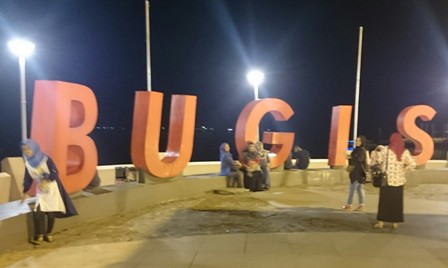
Daylight arrival shows a different side. Makassar occupies an intensely farmed plain edged by sugar-cone shaped forested mountains. Had I more time, a day trip to those mountains would no doubt have provided more informative editorial.
The Bugis people dominate Makassar’s history. Seafaring experts like their Minahasan neighbours to the north, the Bugis have always been adventurers, sailing throughout the archipelago in search of new trade routes and goods to sell or buy.
Makassar has been an important port city for centuries.
Unfortunately, I spent a short night in Makassar between flights, time enough to stroll along the waterfront and to check out what is purportedly the world’s longest restaurant. An extensive line-up of waterfront street stalls selling fried pisang (bananas) with peanut sauce or cheese or chillis seemed the most popular go-to snack. Satay warung, ayam barbecue joints, ikan grills, nasi or mee goreng stands… the whole gamut of popular Indonesian snack food is available, cheap as chips too.
Ambon
The flight between Makassar and Ambon is about 90 minutes yet a world of difference lies in the transit.
Garuda has daily flights from Jakarta and Bali to Ambon via Makassar. A reliable local tourism source in Ambon told me that Garuda flights between Darwin and Ambon are scheduled to commence sometime in late 2016 or early 2017.
When arriving in Maluku the Wallace Line separating Asian and Australian flora and fauna is crossed, though some Australian species such as cus-cus (a type of tree kangaroo) inhabit both sides of the line. In Ambon, Indonesia melds into Melanesia.
Islam mingles noticeably with Christianity as both churches and mosques are scattered around the islands. The historic Dutch influence remains strongly apparent. Most importantly the aroma of spice pervades the air.
Maluku (Molucca Islands) is the original home of clove, mace and nutmeg. In the 17th century Dutch colonists subjugated ’the natives’, forcing them into slavery to work their plantations, stealing their land and as a consequence fomenting a nascent Indonesian identity. The Dutch East India Company was formed in 1602 to protect Dutch national interests, therefore instituting a monopoly on the fabulous riches derived from slave labour and creating Dutch hegemony over the cash-cow Spice Islands until 1799 when Napoleon broke up historic European associations while later acceding to the British as competitors for rampant colonialism in SE Asia.

Overlooking central Ambon is an impressive statue of Martha Christina Tiahahu. Aged 17 she led fights for freedom and independence against the Dutch in the early 19th century. She was also a follower of Kapitan Pattimura, who was born on nearby Saparua Island. He is another Indonesian national independence hero who was hanged by the Dutch in 16 December 1817 aged 34. Pattimura’s daughter continued to fight against the Dutch when she was only 16.
The spirit of independence burns brightly in Maluku.
Today Ambon is a calm small city on a big bay, sleepy in appearance, well-kept and surprisingly inviting.

I shared a special greeting given by Sahureka-reka dancers from a local school at Namalatu beach, about twenty kilometres southwest of Ambon. Sahureka-reka dance is representative of sharing between communities: fish from the ocean, crops from inland i.e. Muslims and Christians living in harmony.
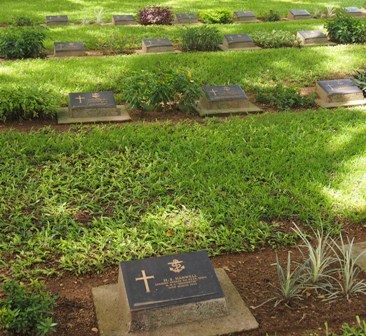
The Australian War Memorial cemetery in Ambon evokes strong emotions of young lives wasted in an exceptionally cruel war. The huge trees shading the graves provided cooling relief, a place to linger and think about mankind’s continuous failure to remember the past while doomed to repeat his mistakes.
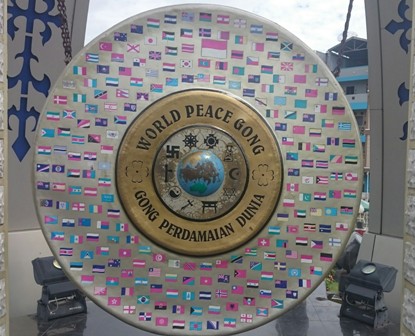
In central Ambon is a traffic circle surrounding a plaza and hill topped with a large and brightly painted gong. Decorated with flags from round the world, the gong espouses universal tenets of peace and justice. The ’Gong of Peace’ hangs from a highly decorated metal and wooden stand. The meaning behind this emblem is clear: live and let live.
Hunimua beach across Ambon Island from Ambon city is a favourite with the locals. It’s a nice place to idle away the hours swimming and chatting with friendly locals.
At Hunimua beach, we were treated to an impromptu ’crazy bamboo’ (Gili Bambu) dance performance. Not quite a performance nor a dance, ’crazy bamboo’ dance consists of eight or more men running in circles with a large bamboo log grasped in their arms trying to dump fellow dancers all the while staying clear of a pyromaniac brandishing a burning torch.

I have no idea what the rules are (neither apparently did the participants) and the dance served no obvious purpose but it was fun to watch. Drinking lots of cold Bintang seemed to help in understanding what the fuss was all about.
Saparua
Approximately 40 kilometres east of Ambon is Saparua Island. 90 minutes by fast boat (or more if the boat breaks down because of motor trouble or propellers becoming tangled in plastic rubbish, both of which happened to our two small boats), Saparua is indeed off the beaten track.

The Dutch heavily fortified the island to protect their lucrative spice trade. The ruins of Duur Stede Fort serve as a reminder of how important the rivers of gold from nutmeg and clove were to the Dutch East India Company. Mercenaries were hired to keep the natives in line, imprisoning the recalcitrant or hanging the most resistant to Dutch rule. (Fans of Frank Herbert’s ’Dune’ novels will undoubtedly see an allegory: Let the Spice Flow!).
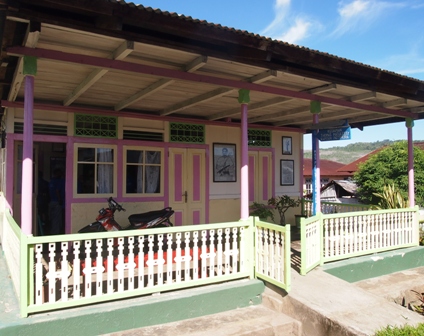
Locally born Thomas Matulessy (whose birthplace in Sirisori village is preserved as a shrine to his memory) became known as Kapitan Pattimura, one of Indonesia’s first independence heroes. A diorama museum next to the fort is worth visiting to gain a sense of how Saparuan people fought against Dutch rule.
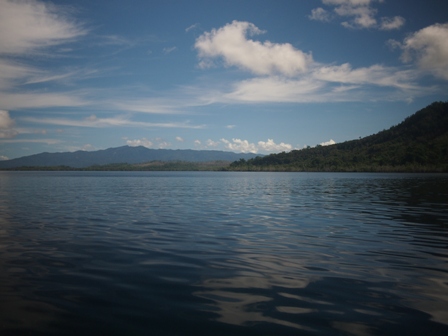
Despite its important and turbulent past, Saparua is now a proverbial sleepy backwater. Here tourism hasn’t had a noticeable impact on local infrastructure.
Boats arrive from Ambon to Haria harbour, Saparua’s main town.
The Perdana Hotel in Haria is approximately ten minutes walk from the Duur Stede Fort or thirty minutes along the main market street from the harbour.
The hotel is my preferred accommodation option. A decent restaurant operates across the road from the hotel entrance.
It’s possible to hire a taxi and driver for a day’s inexpensive touring around the island; that or a motorbike.
Colourfully painted houses populate small villages like hundreds and thousands sprinkled across a birthday cake.

Mosques and churches dominate various villages, indications as to whether the population is primarily Muslim or Christian.
If going by the number of waves and smiling faces we encountered is a reasonably accurate measure of hospitality, everyone seems genuinely friendly and welcoming of foreign visitors regardless of religious persuasion.

The island’s main market operates along the main street from early morning until early afternoon and is clearly the centre of activity.
Sulawesi and Maluku offer rich rewards for visitors willing to forego standard international resort touring in favour of more stimulating travelling.
Tom Neal Tacker travelled as a guest of Visit Indonesia and the Indonesian Ministry of Tourism.
For more information about Indonesia tourism see www.indonesiatravel.com








